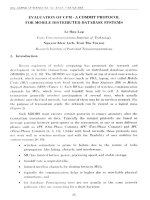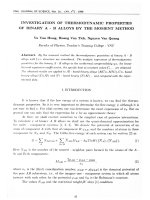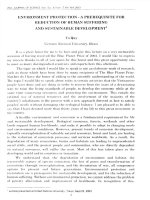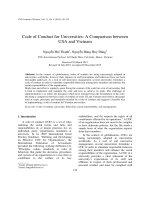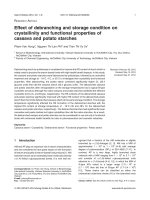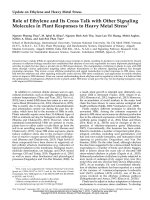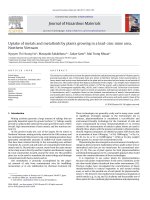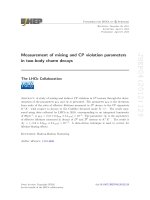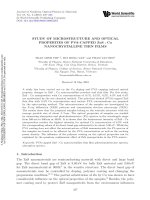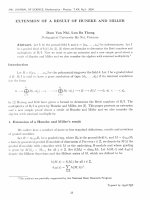DSpace at VNU: Extension of a Result of Huneke and Miller
Bạn đang xem bản rút gọn của tài liệu. Xem và tải ngay bản đầy đủ của tài liệu tại đây (2.07 MB, 6 trang )
/ N U . J O U R N A L O F S C IE N C E , M a t h e m a t i c s - Physics.
T.xx,
N 0 3 - 2004
E X T E N S IO N OF A RESU LT OF H U N E K E A N D M ILLER
D a m V an N h i, L u u B a T h a n g
Pedagogical University Ha Noij Vietnam
A b s t r a c t . Let k be the ground field k and X = (x o ,. . . , x n ) be indeterminates. Let I
be a graded ideal of k[x]. In [2], [3] there are formulas to determine the Betti numbers and
multiplicity of R / I . Now we want togive an extension and a new simple proof about a
result of Huneke and Miller and we alsoconsider the algebra withminimal multiplicity.1
In tro d u c tio n
Let R = k[x 1 , . . . , x n \ be the polynomial ring over the field k. Let I be a graded ideal
>f R. R / I is said to have a pure resolution of type (rfi,. . . , d p) if its minimal resolution
lias the form
tp
0 — >0
R ( - d p ) — ■>-> ®
ji
R ( - d i ) — > R — * R / I — » 0, fil < • • • < dp.
3=1
3=1
111 [2] Herzog anti Kill have given a formul to determ ine the B etti num bers of R / I . The
multiplicity of R / I is given by Huneke and Miller, see [3]. This paper presents an extension
iind a new simple proof ab o u t a result of Huncke and Miller and we also consider the
algebra w ith minimal multiplicity.
1. E x t e n s i o n o f a H u n e k e a n d M i l l e r ’s r e s u l t
We collect here cl num ber of more or less s tan d a rd definitions, results and notations
of graded modules.
Let R = Q>i>oR, be a graded ring, where Ro is the ground-field k, and M = © tez M t
a finitely generated graded i?-m odule of dim ension d. For evry i G z , we denote by M( i ) the
graded R -m odule w ith coincides w ith M as th e underlying 7?-module and whose grading
is given by M(i,)j = M i+ j for all j € z . Set i ( Mt ) = dini/fc Mị . Let h ( M, t) and ì i m ( z )
denote the Hilbert functions an d th e H ilbert series of M, which are defined to be
h { M , t ) = £( Mt ) for all t e z ,
h M (z) = Y ^ h ( M , t ) z t .
t ez
1T h e authors are partially su p p o r te d by the N a tio n a l Basic Research Program
Typeset by
23
D a m Van N h i , L u u B a Thang
24
It is well known th a t h ( M , t ) =
The multiplicity of M is defined as follows
e (M ) =
0 j J) w ith ej €
eo
if d > 0 ,
£( M)
if rf = 0.
Suppose th a t 0 — > ® j L i R ( - d p j ) — >
z and
Vi > > 0.
— » ® j l i R ( ~ d 0j) — * M —
minimal graded free resolution of M . Since hji(z) =
{t+n~[i ) zt = (i-~ )n and
h M (z) = £ ( - 1 )* £ > « ( - * , ) ( * ) = x > i r (
i—0
j —1
i —0 1
(1 - z ) n ^
'1 2—
v
i=00
jj==l l
(1 - 2 )
v
d with g(z) G /c[z]
'
there is (1 - z ) n~dg(z) = XZi=o(—1 )i (53Ít=i *dij) := S m ( z ), see [1].
T h e o r e m 1 . 1 . [2, Corollary 4.1.14] I f M is finitely generated graded R -m o d u le o f dimen
sion d , then
( _
1 \ n — d Q ( n ~ d + j ) ( -i \
/ ' _ 1 \™ — d o ( n ~ d ) / « \
= ( ir
.. 2 _ J 1 ) and e(M ) = (
(n — d + j)!
j
M
(n — d)!
(
■
Let M be a finitely generated graded jR-module. M is said to have a pure resolution
of type ( c/oj ^ I j • • • >^p) if its minimal resolution has the form
-
tp
0 — > 0 R ( - d p) — > > ©
t\
7 ? (-d i) — > ©
.7= 1
j=l
Íq
R ( - d o ) — > M — > 0, do < ■• ■< dp.
j=l
The following theorem shows th a t
the B etti numbers and multiplicity of th e
CohenMacaulay module M are completely determined by the twists di and Betti num ber ỂQ.
T h e o r e m 1.2. Let M be a finitely generated graded R -m o d u le o f dimension d. I f M is a
Cohen-Macaulay m odule and has a pure resolution o f type (do, d ị , . . . j dp), then
0—
—(( 1)1\iT-TPnj=i(4>
~dj) ' ^ 1 • • • >p> e(M
(Kf)\ —
_ (—1)P^0rr,,
/ , _ 7 \ ’?' “
liiz = o .i^ iv a i
aj)
V-
JN
dj).
. ,
3 =1
Proof. Since M is a Cohen-Macaulay module, there is p = n —d and 5 a/(z) = (1—z)p<7 ^ ) =
XI ?=o( —
- Since
(!) = 0 for j = 0 , 1 , - • • ,p — 1 , an d 5 ^ ( 1 ) = 5 ( 1 ), we obtain
the following system of linear equations:
r £ L o ( - i ) ^ = 0,
E L o ( - i ) % d i . ( d i - 1 ) . . . (di - j + 1) =
0,
j = !,■■■ , p - 1,
, E f= o ( ~ l ) %d i . ( d i - l ) . . . ( d i - p + l ) = g( 1 ).
25
E x t e n s i o n o f a r esu lt o f H u n e k e a n d M i l l e r
Set y, = ( - 1 ) 7 , , 1 = 0 , . . . ,p. Upon simple computation, we get
£ ? = 0 y* = °>
'
E L o V i d ị = 0,
(A)<
1 1 ■■ ■ I p
J
I E L o y i d pi = g { i ) -
Consider the following equation
g[l) ________________
5(1)
( i - do){x - di ) ■• • (x - dp)
_______________
_
Xị
Xọ
X -
do
X -
x2
+
dỵ
X - d2
Then (D) : g( 1) = xq( x — d\) • • • (x — dp) + x \ ( x — do)(x
d0){x - d p - i ) . For X = d 0 , x = ( * ! , • • • , x = dp,
(Ỉ2 ) • •'
i t can b e
dp) + • • • + xp( x
v e r i f i e d th a t
ỡ(i)
x 0 -
£1 =
(C)
X'? =
«
_
(d o -d i)- (d o -d p )’
gO)
( d i- d o ) - ( d i- d p ) ’
_________ gill_________
( d 2 - d o ) ( d 2 - d i ) - ( d2 - d p ) ’
_________ gili _____________
p [ d p —do ){dp
d \ ) •••[dp —d p —I )
The ith power sum and the ith elementary symmetric polynomial of d o , . . . ,dp will be
denot'd by Mt = ^0 + ■■■~t~
identity Et —
fỉ''
;r/J • • • , X, f r o m
the above
a n d Et — Eị ( d o , . . . ,dp). Set E t
1J
— (Et)di=0 - Use the
iri8.tlioniiitiCiil induction to CcLCul&tG the cocfficicnts of
e q u a t i o n ( £?) i t f o l l o w s t h a t
f E f = o ^ = 0.
( ^ ) < j = 0 , • ■•
(
x q ( ỉ ,q
+ X i d i H----------4- X p d P =
5 ( 1 ).
From (A ),(C ) and (Ơ) it follows th a t 2/j = Xj,i = 0 , . . . ,p. Since 5 ( 1 ) = x o Y l j =1(do - dj),
there are
n ;=0
-4)
Consider
x(x - 1) • • • (x - p + 1) _
Zo
Zi
x ( x — 1 ) • • • (x - p + 1 )
X — d,
( x — d o ) ■■• ( x - d p )
X - do
X - d\
zo(x - di) • • ■(x - dp) + Zi (x - do)(x - d2) ■■■{x - dp) + ■■■+ zp (x - do) ■■• (x d p - 1 )
There is z0 + ----- h zp = 1 and for
X
= d0, ■■■ , X = dp we obtain
c io (d o- l) -
-
(do- dl)di(di- l)-
-
I
( d o—p-f-1)
■■(do-dp ) ’
■( d i - p + 1 )
( i l l —do)- - ( d i - d p )
d „ ( d v - D - ..( d p -p + 1 )
(dp-do)" ( d p —dp —1 )
’
D a m V a n N h i , L u u B a Thang
26
Since e ( M ) = —
y y( 1) , therefore
C[M) = ( - i K S f f ( i ) = ( - 1 K £ i - y e M d. - 1 )
= 1—
P!
fV '
ảí
p + 1)
- 1 ) ■■• (<^i - p + 1 ) ' _ ( - l ) pg ( l) y -r
r ij/ i( d i- d j)
“
p!
= (-!)"< /( 1) = ( - I ) ^ o ( d o - d i ) d o - c f 2) - - - ( r f 0 - d p)
p!
p!
Thus e (M ) =
n ; =1(d0 - rfj).
Now we want to consider th e case the finitely generated graded /?-mođule M is not
Cohen-Macaulay. In this case we have p = proj. dim M > n — dim M = n — d.
T h e o r e m 1.3. L et M be a finitely generated graded R -m o d u le o f dimension d. I f M
has a pure resolution o f ty p e (d0, d y ,
, d p), then all ii are com p letely determ ined by
• • - >^ p —n + d ■
Proof. Set xji — ( —l)*^i for i = 0 , . . . ,p. By assum ption, direct c o m p u ta tio n shows that
£ ỈU
k
=
o,
E ? = o ^ = 0,
j = 1, ••• ,n - d - 1 ,
H U M ”" 14* = s‘ >(1).
/i = ().... ,p — n + d.
Denote the su m m atio n of all p ro d u cts of n-h factors from ri0, .. . , d j _ i , d i + i , . . . ,dp by Sih
and set uh —
1 ). By an argument, analogous to t h a t used for the proof of Theorem
1 .2 , wc get th e solution
y° = n''=i(4>-dj) s£=n-= nn'-=
i o oK
i . --dj)
^ ) ^52P
I Vl ~
h h==nn--dd a hSih,
I 1 = 1 , . . . , p.
Thus
ị T i = n - d a h Sữh = W
< E L n -i^ O h =
[ i =
JL i u m
Lino s y s t e m
J = M o - dj)>
P
- d j).
1, . . . , p - Tl + d .
wt; tcM
t c i i i i iin
iie
e aall
i l Cị when
w xien £
t oq,.
, . ...
. ,, C
p - n + d aare
re given.
Ui1 ud ceterm
£p_n+(i
Let I be a homogeneous ideal of R. R / I has a pure resolution of type ( d i , . .. , dp)
with its m inim al resolution of th e form
tp
ii
0
R ( - d p ) — > • • • — > ( Ị ỳ R ( - d i ) — > R — * R / 1 — > 0, d\ < • • • < dp.
j=1
j= i
T he following result was proved by Huneke and Miller using residues theory of complex
function, see [3]. As an im m ediate consequence of Theorem 1.2 we now want to give an
an oth er simple proof.
E xten sion o f a result o f H u n eke and M ille r
27
C o r o l l a r y 1.4. [3, T heorem 1.2] L et I be a homogeneous ideal o f R. If R / I is CohenMacaulay and has a p u re resolution o f typ e ( d i , . .. , dp), then
i#j
Proof.
à ủ".
J
j= 1
Here Ĩ.Q
£o =
= 1l,d
,^ o
0 = 0u. By
b y TIhheorem
e o re n 1.2, we have g ( l ) = d \ . . . d p . Hence t j =
( - I >i+ 1 r u i r f h ; ) and
Note t hhat
a t T hheorem
an extension of Corollary 1.4.
eo rem 1.2 is as considered
consider
R e m a r k 1.5. I f we present (x - l ) ( x - 2) ■■■( x - p + I) = x p - Sị X?-1 + S2 XP~ 2
----- f
( - l ) p - 1 Sp_ix, then
(-1 ỹiidiidi - l ) - - - ( d l - p + l )
= (-1 )^ i[< -
S y d pr l + s 2 d p ~ 2 -------- + ( - 1 y - ' s p - i d i } .
Since £ ? =1 y%4 = 0, j = 1 , . . . , p - 1, and since do = 0, we obtain
......
p. — -------------- -L------------ = ---------- ----------- by T h eo rem 1.1
( n - d + i )\
(p + j ) !
= 7T ~ ~ 7 \T F ( - l )% d i(d i - 1 ) ■• • (di - p - j + 1 )
(p + JV-frt
=
T i - i y w d i - 1 ) • • • (di - p - j +1)
(p + j)! ^
(p + i Y Ế Í
III particular, for j = 0 there is e { R / 1) = Ặ E L i ( - 1 )P+i^ d i » (form ula o f Peskine-Szpiro),
see [3].
Assume th a t / 7 ^ 0 is a homogeneous ideal of i?. D enote by v ( R / 1) = h ( R / / ; 1) the
embedding dimension of R / I . Abhyankax proved th a t if R / I is C ohen-M acaulay then
v { R / I ) - dim R / I + 1 □ e { R / I ) .
Recall th a t a C ohen-M acaulay local ring R / I is called a ring with m in im a l m ultiplicity if
v ( R / I ) - dim R / I + 1 = e ( R / I ) . We will say th a t R / I has h-linear resolution if R / I has
the pure resolution of ty pe (h, h + I , . . . , h + p — 1 ).
P r o p o s i t i o n 1.6. A s s u m e th ã t the ring R / I is Cohen-AIãCãuIãy ãiid hãs a h-hneãr res
olution o f ty p e (h, h + 1, • ■• , h + p - 1) ,p = 7 1 - dim R / I . R / I is the ring with m inim al
m ultiplicity i f a n d only i f h = 1 or h = 2.
Proof. Since R is th e Cohen-M acaulay ring, there is ht(7) =
Corollary 2.1.4]. Because R / I has a /i-linear resolution of type
n - dim R / 1 = p by [1,
( h , h + 1,• • • , h + p - 1),
D a m Van N h i , L u u B a T h a n g
therefore Ij = 0 for all j < h and dim/c I h =
*). If h = 1, then e { R / I ) =
= 1 and
u( R/ 1) = (n 1 + 1) “ dirrifc/i = n — p. Hence / ? / / is the ring with minimal multiplicity,
because
v ( R / I ) — dim 7 ?// + 1 = (n —p) — (n —p) + 1 = e ( R/ I ) .
3 / Theorem 1.2, we have
c { m
= A
h h ± ± L ■:
+ p - 1> > Ĩ ± 1 ± ± 1 > = p + Ị
p!
= ^
^
p!
^ — (n —p) + 1 = v ( R / I ) — dim R / I + 1.
^ so, in the case h > 2 , the Cohen-Macaulay local ring R / I is a ring with minimal
multiplicity if and only if h = 2. Hence, the Cohen-Macaulay ring i ? / / , which has a hliiear resolution of type ( h ì h + 1, • • • , h + p — l ) , p = n —d i m R / I , is the ring with minimal
nultiplicity if and only if h — 1 or h = 2 .
references
1 . D. Einsenbud,
s. Goto,
Linear free resolution and minimal multiplicity, J. Algebra
88(1984), 89-133.
2 . J. Herzog, E. Kunz, Der kanonische Module eines Cohen-Macaulay-Rings, Lecture
Notes in Math., Vol. 238, Springer-Verlag 1971.
3 . c. Huneke, M. Miller, A note on the multiplicity of Cohen-Macaulay algebras with
pure resolution, Canad. J. Math., 37(1985), 1149-1162.
